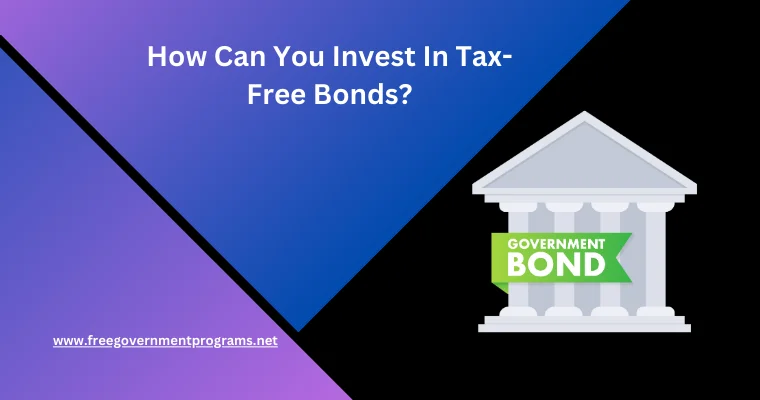Tax Free Government Bonds – Secret to Maximize Your Savings
As an investor, would you pick investments where you pay taxes on what you earn or ones where you don’t? The choice is clear. Investors love tax-free investments. Bonds can be either taxable or tax-free. In contrast, tax-free bonds do not require you to pay taxes on your earnings. Moreover, these bonds are safe and make good money. If you want a safe investment that gives you more money back, go for tax-free bonds. Besides this, Tax free government bonds stand as a valuable investment option for individuals who are seeking reliable options to grow their savings.

However, governments issue these bonds at various levels, such as local, state, or federal. They also offer investors an opportunity to earn interest income exempt from federal taxes. In this article, we will explore Tax-Free Government bonds, their features, and their advantages for individuals.
What Are Tax-Free Government Bonds?
Tax-free bonds are government bonds aiming to provide regular income that’s free from taxes. These bonds, also known as tax-free government or municipal bonds, are issued by government bodies like municipal corporations or NHAI to collect funds for big projects. They’re long-term investments, sometimes called tax-free municipal bonds. Yet, remember, you shouldn’t plan to take out your invested money quickly. These bonds have a lock-in period of over 10 years because they fund large projects. If they’re listed, you can trade these bonds on bond markets.
Additionally, Tax-free bonds pay less interest than regular ones because of tax perks. That’s called the tax-free bond yield. But remember, only the interest is tax-free. If you make money selling or when the bond matures, those profits are taxable. Bonds from places like NHAI or REC are popular in India for being tax-free.
Popular Tax-Free Bonds:
Here is a popular list of Tax-Free bonds available in 2024.
- Power Finance Corporation tax-free bond
- Housing and Urban Development Corporation tax-free bond
- National Bank for Agriculture and Rural Development tax-free bond
- Indian Railway Finance Corporation tax-free bond
- National Highways Authority of India tax-free bond
- Rural Electrification Corporation tax-free bond
- Indian Renewable Energy Development Agency tax-free bond
Common Types Of Tax-Free Bonds:
Some of the common types of Tax-free bonds, such as
- Infrastructure Bonds
- Housing Bonds
- Power Bonds
- Railway Bonds
- Public Sector Unit
Features & Benefits of Tax-Free Bonds:
1. Fixed Interest Rate
Tax-exempt bonds pay a fixed interest that comes regularly. You get this money until the bond matures. Because government bodies handle these bonds, the interest is generally safe. Usually, the interest is paid every six months or once a year.
2. No Taxes On Earnings
The interest you get from these bonds is tax-free. That’s why it’s called the tax-free bond rate. But if you sell or redeem these bonds, any profit you make is taxable under the Income Tax Act 1961.
3. Highly Secure
Investing in these bonds is super secure. Government bonds hardly ever fail to pay back. That’s why they’re the best choice for investing.
4. Less Accessible
Tax-free infrastructure bonds have a fixed time when you can’t take out your money.
You have to wait until this time is up before withdrawing. That’s why these bonds aren’t as easy to get money from compared to other investments.
5. Long Duration
Government bodies like NHAI, REC, etc, issue infrastructure-related bonds. Because the projects these bodies work on take a long time, the bonds usually last more than 10 years.
How Can You Invest In Tax-Free Bonds?
There are two ways to invest in Tax-Free Bonds:
1. Bond Issue
During the subscription period, you can sign up for these bonds. You can apply either online or offline by filling out a form and providing your KYC details, such as your PAN Card.
2. Through Trading
After they’re issued, you can buy tax-free bonds online using a trading account through a broker. You can also trade these bonds in the stock market using your Demat account. However, government agencies release tax-free bonds periodically for different projects. So, it’s essential to stay updated on upcoming bond issues.
Furthermore, It’s advantageous to invest in these bonds at their initial price because as bond prices increase, the remaining interest payouts become lower, making them less attractive for investment.

How are Tax-Free Bonds Taxed? – Tax Implications on Tax-Free Bonds?
- Interest earned from tax-free bonds is tax-exempt if you keep the bond until it matures. Therefore, there’s no TDS (Tax Deducted at Source).
- However, if you sell the bonds in secondary markets, the transactions are eligible for tax deductions.
- If you sell a specific bond after holding it for more than 12 months, the profit will be taxed at a rate of 10%.
- But, if the bond is sold within 12 months in secondary markets, the capital gains will be taxed based on the Income Tax slab.
- Tax-free bonds are recommended for individuals in higher tax brackets.
Consider Arun and Jay, both earning Rs. 20 lakhs a year. Arun invests 2 lakhs in a fixed deposit with a 6% annual interest rate. Meanwhile, Jay opts for tax-free bonds, investing Rs. 1 lakh at a 5.5% annual interest rate for 10 years. In this scenario, both Arun and Jay are in the 30% tax slab.
How To Redeem Your Tax-Free Bonds?
Tax-free bonds are quite simple to cash in. You keep them until they mature, then sell them back to the bank or company that issued them. This way, you get a steady tax-free income. You can also trade these bonds in a marketplace to make some profit. But the profit you make might be taxed by the government.
In addition, if you sell these bonds in less than 12 months, the tax will depend on how much you earn. Selling after 12 months means you’ll be taxed at a fixed rate of 10% on the profits you make.
Things To Remember Before Opting For Tax-free Bonds:
Tax-free bonds are among the safest investment options due to their extended lock-in period. Therefore, investors should carefully assess their finances before committing to these bonds.
Additionally, financial advisors recommend these bonds to reduce tax obligations and diversify portfolio risks. Consequently, tax-free bonds are highly recommended for individuals with high incomes. Hence, it’s crucial to consider a few factors before investing:
- Tax-free bonds have a lock-in period of 10, 15, or 20 years. You’re unable to redeem them before the specified period ends.
- The interest earned on these bonds is tax-exempt and deposited directly into your bank account each year. Upon maturity, you’ll receive the initial invested amount.
- Tax-free bonds are tradable in the exchanges open for anyone to trade in the secondary market.
- If the bondholder sells the bonds within a year, the profit made will be taxed according to their income tax slab. However, if the bonds are sold after a year, a fixed 10% tax will be applicable on the profit made.
- The majority of tax-free bonds are issued by Public Sector Units (PSUs), resulting in very low credit risk or the risk of non-payment.
- Tax-free bonds are issued in both physical and digital forms.
Who Should Invest In Tax-Free Bonds?
Tax-free bonds are a great pick for senior citizens because they offer long-term fixed income and have a low risk of not paying back the investment. Moreover, people who pay a lot of tax, like high-net-worth individuals, family groups, and certain institutions, should consider investing in tax-free bonds for better returns.
What Are The Commonly Found Tax-Free Bonds?
Various public sector undertakings provide tax-free bonds, including.
- NTPC Limited,
- Rural Electrification Corporation,
- National Highway Authority of India,
- Indian Railways
- Indian Renewable Energy Development Agency
- Power Finance Corporation
- Housing and Urban Development Corporation
- Rural Electrification Limited
What Is the Difference between Tax-Free Bonds and Tax-Saving Bonds?
There are significant differences between tax-savings bonds and tax-free bonds. Here are the primary distinctions between the two:
| Tax-Saving Bonds | Tax-Free Bonds |
| With these bonds, the interest earned is exempt from taxation. Only the initial investment is tax-free in such bonds. | In these bonds, the interest earned from an investment is exempted from taxation, as per Section 10 of the Indian Income Tax Act, 1961. |
| Tax-saving bonds have restricted investment options. | Any individual investor can invest up to 5 lakhs in tax-free bonds. |
| Such bonds offer a buyback option every 5 or 7 years, enabling investors to retrieve their investments. | These bonds have a lock-in period. |
| Tax-saving bonds provide a lower interest rate in comparison to tax-free bonds. | Such bonds provide a higher interest rate compared to tax-saving bonds. |
| These bonds are considered investment options for individual investors who can claim a tax exemption of up to Rs. 20,000 under section 80CCF of the Income Tax Act. | Tax-free bonds are entirely exempt from taxes and have no investment limits. |
Eligibility Criteria for Tax-Free Government Bonds:
The eligibility criteria for tax-free government bonds include the following aspects. Such as,
- Tax-free bonds usually take around ten years or more to mature.
- Hindu Undivided Families(HUF) and Non-Residients Indians (NRI)are eligible for these bonds.
- Most tax-free bond issues do not have a specified age limit for investors.
How To Apply For a Government Tax Bond?
The application process for a Tax-Bond includes the following steps such as
1. Opening a Demat Account:
To invest in tax-free bonds, you’ll need a Demat account. If you don’t have one, open an account with a registered Depository Participant (DP).
2. Choose the Issuer:
After picking the bond you want, complete the application form provided by authorized agents or apply online using specific websites.
3. KYC Documentation:
Complete the Know Your Customer (KYC) process by submitting required documents, such as PAN card, address proof, and identity proof.
4. Form Submission:
Complete the bond application form with the right details and attach the required documents. Make sure everything is accurate to prevent any issues.
5. Payment:
Make the payment through cheque, demand draft, or online transfer as per the specified payment methods mentioned in the application form.
6. Allotment:
Once the subscription period ends, the issuer allows the bonds based on the demand and available quantity.
After successful allotment, you’ll receive an allotment advice or bond certificate confirming your investment. Keep this safe for future reference. Periodically, your bank account will receive the credited interest amount.
Conclusion
Tax-free government bonds let you earn interest without paying taxes on that income. They might have lower interest rates than some other options, but they’re great for people in higher tax brackets who want to save on taxes while growing their money.
Furthermore, Tax-free government bonds are a hit because they don’t charge federal taxes on the interest you earn from them. If you live in the same state as the bond, you might even skip paying state and local taxes on the interest money you make, which makes these bonds a super tax-friendly option!
However, before jumping in, it’s smart to think about a few things, like checking the bond’s credit ratings, making sure the organization issuing the bond is financially stable, and when it matures.
Frequently Asked Questions (FAQs)
Are tax-free government bonds completely risk-free?
No, all investments carry some level of risk. Investors should consider factors like credit ratings and the financial health of the issuing entity.
Who can issue tax-free bonds?
Government bodies typically issue tax-free bonds available on the National Stock Exchange (NSE) to gather funds for constructing infrastructure projects like roads and bridges. Investors often favor bonds from organizations such as NHAI, REC, HUDCO, NABARD, and similar groups.
How much can I invest in Tax-Free Bonds?
You can invest any amount that aligns with you best. However, the amount may fall between 20000 to 50000.
Are tax-free government bonds suitable for all investors?
Tax-free bonds are good for folks in higher tax brackets looking to save on taxes while growing their money. However, before investing, one should consider individual financial circumstances.





